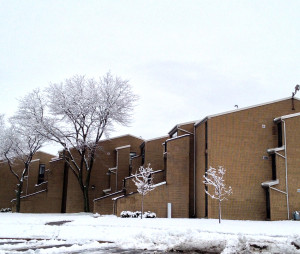
The Shoreline Apartments designed by Paul Rudolph, were built in downtown Buffalo in 1974. Five of the buildings are under threat of demolition.
Buffalo has some of the best and most groundbreaking architecture in America and indeed in the world. As one of the few cities with masterpieces by Richardson, Sullivan, and Wright, it has long been a destination for students and lovers of architecture. And in recent years, a renaissance of sorts is reviving its landmarks and reactivating the neighborhoods. Grain elevators and daylight factories that influenced LeCorbusier, Erich Mendelsohn and Reyner Banham are finding new life while Richardson and Olmsted’s long vacant Buffalo State Asylum for the Insane becomes a boutique hotel, conference center and architecture center. Wright’s Darwin D. Martin House has been restored and reconstructed and Sullivan’s Guaranty building, often called the first real skyscraper, has been restored for a second time in 25 years. Buildings by Richard Upjohn, Daniel Burnham, and the Saarinens fill in the landscape. But what is less recognized is that Buffalo’s architectural innovation continued through the modern era and these traditional icons can be found across the street from buildings by Yamasaki, Edward Durrell Stone, SOM, I. M. Pei and Paul Rudolph. And like much of the rest of the country, Buffalo’s preservationists are now finding themselves in the midst of battles to save its modern architecture. For the rest of this article, see this month’s Special Brief on Public Housing in the Docomomo_US Newsletter.
And if you’d like to “subscribe” or follow my blog, True Green Cities, please sign up through the “Subscribe” button at the bottom left of this page. You’ll receive a daily recap when new blogs are posted. Or Sign up for the Feed.
